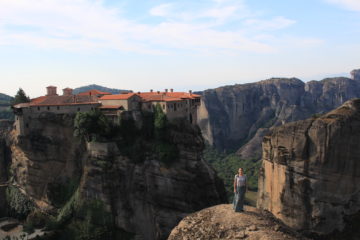After spending a week in the sprawling metropolis of Beijing, we decided we needed to briefly decamp to a quainter, rustic location in China for our next series of adventures. This led us to the “tiny” town (read: population of ~3.5 million) of Datong, which is situated approximately 6.5 hours by train northwest of Beijing. It should come as no surprise that China is basically the only country in the world (except for probably India) where a city this size would barely be identified on the map. Super strange.
Given that our lodgings in Beijing were less than optimal (not bad, but not nice either), we decided to treat ourselves to a nicer hostel while in Datong. Fortunately, since nobody seems to visit this damn city, we were able to secure a quite luxurious hostel room for a mere $40/night. This luxurious room included an actual shower (instead of a wet bath, which is ranked in the top 5 of my least favorite things in the world), ergonomic pillows, heated toilet seats and shrink-wrapped plates of fruit delivered daily to our room. Pure luxury…by backpacker standards.
The real purpose of our visit to Datong was to visit the two sites described below, which we decided to cram into a single day (despite some slight logistical impediments associated with doing so) because the weather forecast indicated that we only had a single sunny day in Datong. After our suboptimal, rain-soaked Great Wall of China experience, we thought it was worthwhile to hire a ridiculously energetic and positive-spirited Datong taxi driver to shepherd us all around the city for a day for a whopping $50. He was old enough to be our grandfather, but still was jumping over barricades, jogging around and strutting like he owned the whole city – my personal (Chinese) hero. [Editor’s note: he didn’t speak a word of English, but made a habit of taking tourists around the city, evidenced by the portfolio of photos with past visitors he scrolled through on his phone for us. He gestured for us to take pictures when driving past scenic sights, which we dutifully did, and even brought a snack he gave us around lunchtime. He clearly knew what he was doing; it was great. And yes, we ended up in a photo on his phone too.]
Hanging Monastery
Our first stop of the day, this is located roughly 90 minutes outside of Datong. This Buddhist monastery was built in 491 AD and is ~160 feet off the ground, nestled into the side of the mountain. This monastery isn’t particularly historically significant (aside from being super old) and it doesn’t have very interesting altars or ornate features like some of the other temples we’ve seen thus far. Instead, the construction of the structure itself is what makes it incredible.
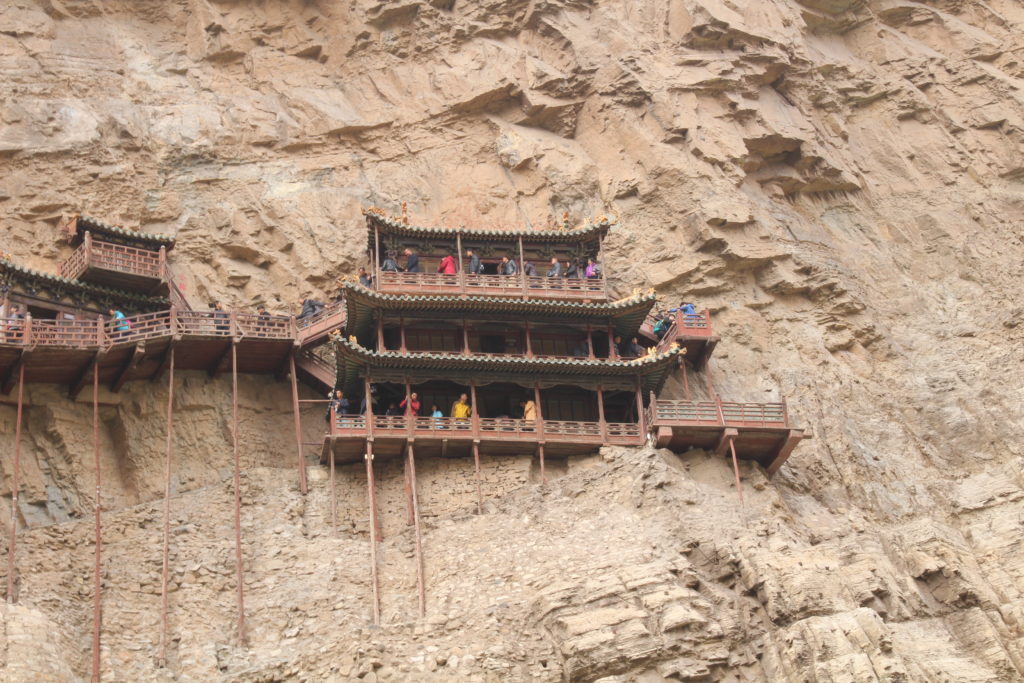
The Hanging Monastery
Look closely at the picture of it. You see massive stilts that appear to be supporting it from its base, right? Wrong. Those vertical poles do not actually bear any of the weight of the monastery structure – they were solely put in place to assuage the fears of citizens who were too afraid to set foot in the monastery without them. In reality, the construction of the monastery is far more remarkable. As you can see when you get deep into the bowels of the building, the only thing keeping it from plunging into the bottom of the canyon are the massive wooden beams that were inserted into holes carved into the side of the cliff. These wooden beams bear all the weight of the wooden components of the monastery, which is supplemented by some enclaves, rooms and stairs that were also carved into the side of the cliff.
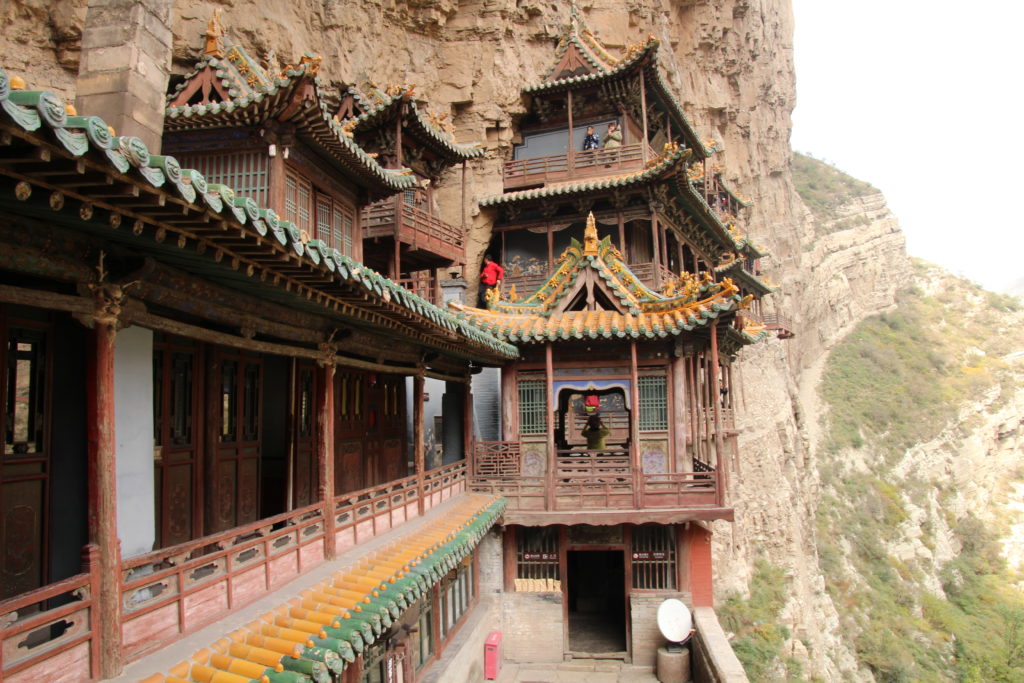
View from inside part of the Hanging Monastery
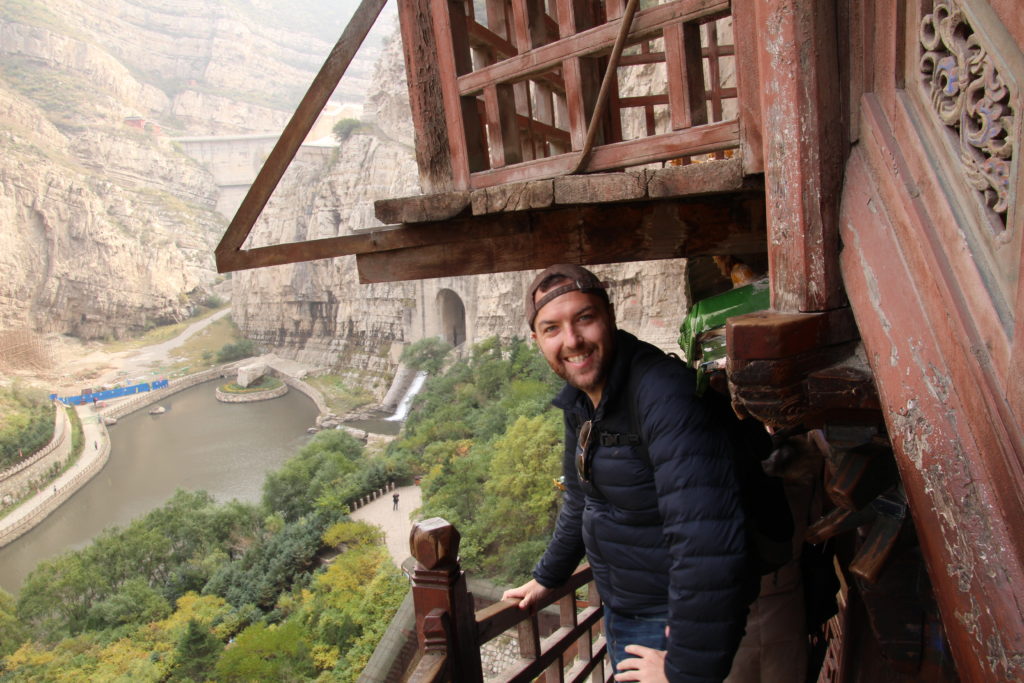
Rorie in the Hanging Monastery. Definitely on the side of a cliff, all right.
One of the craziest things about this whole thing is that this superior craftsmanship has endured for 1,500+ years, as well as the many thousands of tourists who have walked on it over time. In fact, when walking along some of the platforms you could feel the whole thing gently move under the weight of all the Chinese tourists (and us) on it at that time. Quite incredible. This helped us better understand why Time Magazine ranked this as one of the 10 most odd, dangerous structures in the world. [Editor’s note: I did not know this until *after* we went to the monastery. Sorry, mom.] Further, it makes sense why we’ve heard recent rumors that they may soon stop permitting tourists to enter the monastery, given the damage being caused to the structure over time. This makes us all the more fortunate to have visited it.
Yungang Grottoes
While the Hanging Monastery is located 90 minutes in one direction from Datong, the other attraction on our list – the UNESCO World Heritage Site known as the Yungang Grottoes – is located 40 minutes in the opposite direction of the city. Our 2 hour taxi ride between destinations included us taking cat naps in the back seat of the cab (we REALLY trusted our driver, perhaps a little too much) and attempting to use Google Translate to convey to him that we somehow needed to get lunch in between.
Once we eventually arrived at the Yungang Grottoes, we were simply blown away. The Hanging Monastery was cool, but these grottoes were far and away the best and most impressive thing we’ve seen so far in China (and yes, that includes the Great Wall of China). The grottoes were built beginning around 400 AD until approximately 525 AD, resulting in 53 massive caves and thousands of other smaller niches and carvings. All around these grottoes, which were carved into the side of a mountain, is a beautiful complex complete with several temples (one of which includes the largest wooden carving of a Buddha in the world), a winding river and lovely grounds.
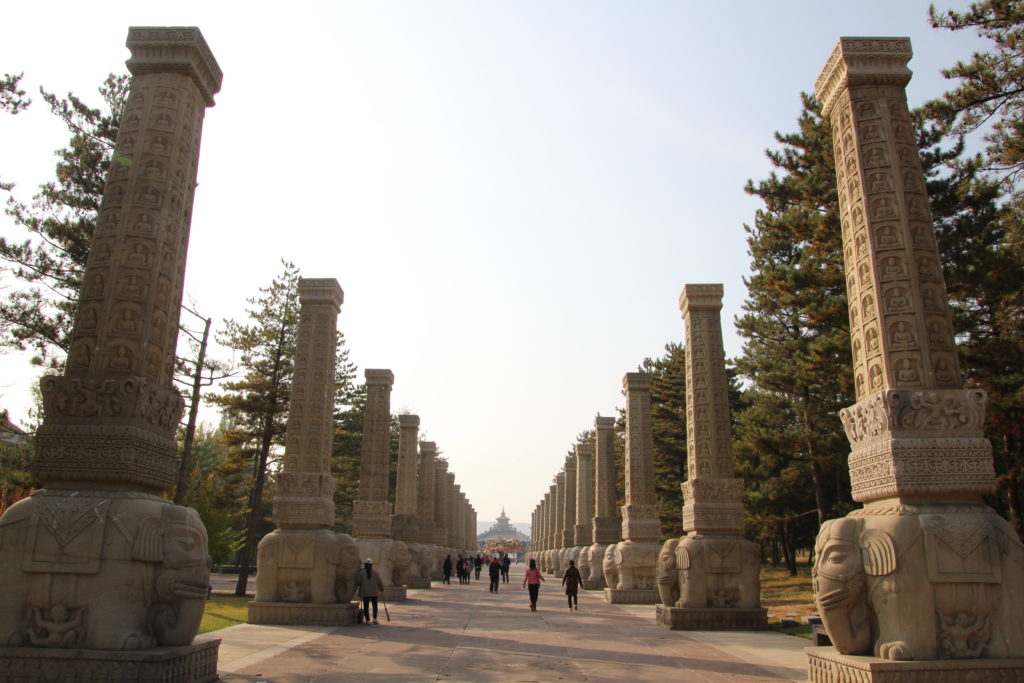
The walkway toward the grounds of the Grottoes.
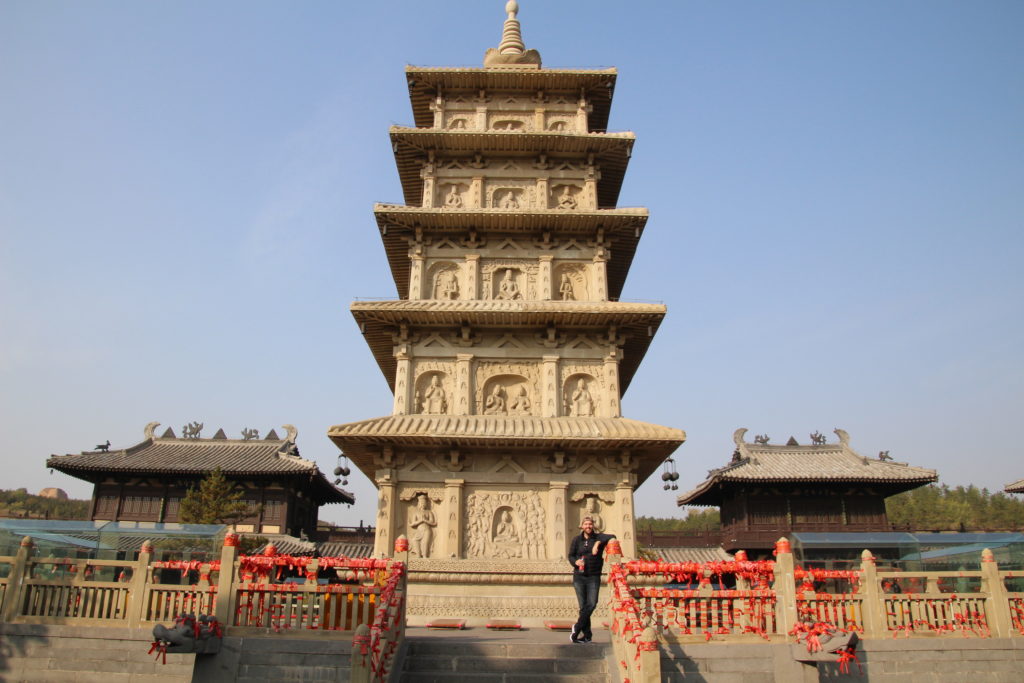
Rorie at one of the pagodas on the grounds – crazy that something this impressive is basically an afterthought given that the real sights are the grottoes themselves.
Anyway, back to the grottoes. So we first walked through the temples and grounds – which were very nice, but unexceptional relative to others (obviously we’re super spoiled already…) – before being routed to the mountains. The first open faced cave or two we came upon had modest, human-sized, severely weather-disfigured Buddhas in them and we were, suffice it to say, underwhelmed. Worried that we’d been duped by this whole tourist site, we then came upon cave number 5. There we walked into a cavern to find an immaculate Buddha standing over 50 feet tall which had been carved solely out of stone, along with phenomenally intricate smaller Buddhist figures and other images all into the walls and ceiling of the room. We were completely blown away. It was jaw dropping that they were able to achieve such ornate carvings over 1,500 years ago which have stood the test of time.
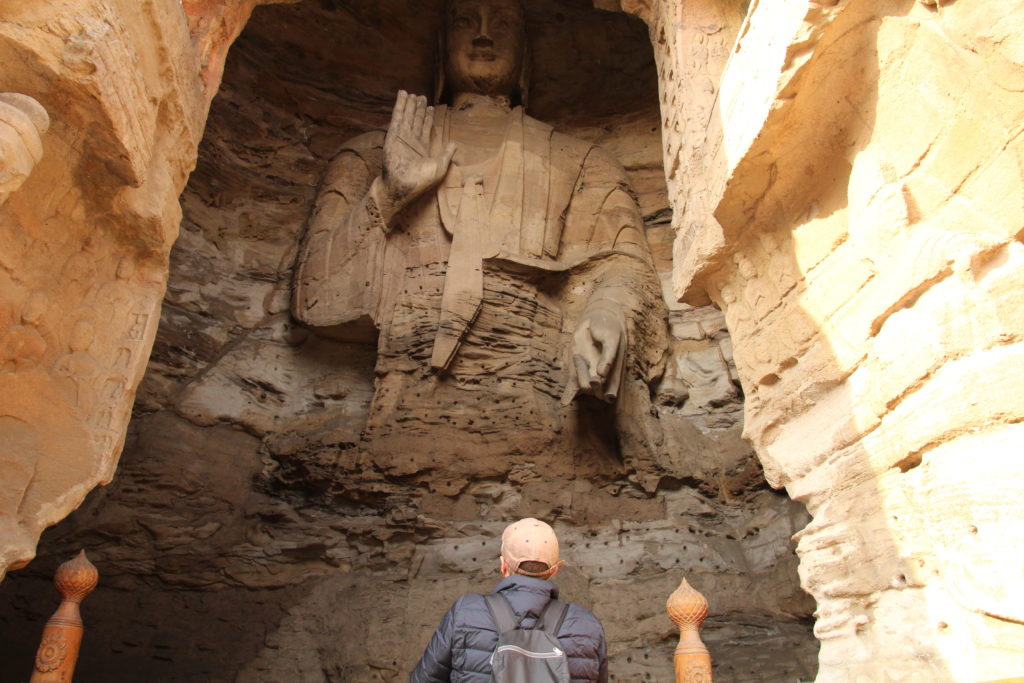
Rorie looking at one of the open grottoes, complete with massive (though relatively medium sized) stone Buddha

Giant carved Buddha at Yungang grottoes with people for scale at the bottom
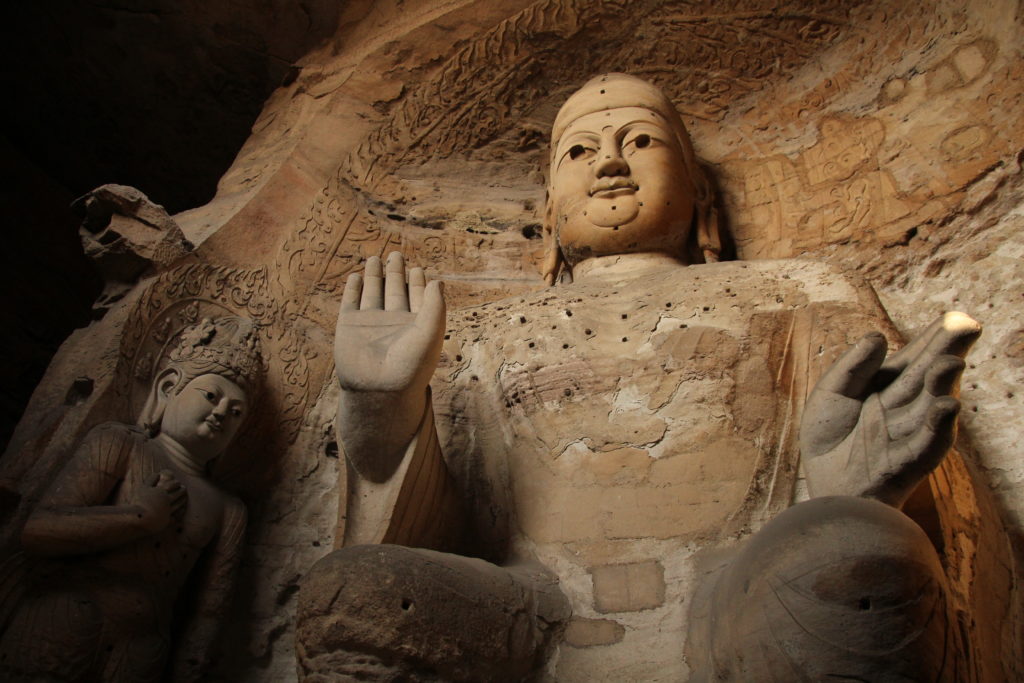
We lingered in cave number 5 for a while to just try and appreciate what we were seeing, thinking it was the apex of our time here. Nope. Couldn’t have been more wrong. It was somehow outdone by the next cave number 6, which had an even taller Buddha, even more ornate carvings and colors adorning these carvings which were remarkably vibrant given how long ago they were applied. It was simultaneously stunning and humbling. The authorities sought to rain on our parade by imposing a strict “no pictures” policy for these rooms, replete with a soldier standing watch at the door. To do the truly American thing of circumventing this policy, Jess and I took turns standing watch and shielding each other so the other could sneak occasional pictures. Marvel at our rebelliousness! [Editor’s note: And please forgive the slight blurriness, as these were surreptitiously shot without time to properly focus!]

A sneakily-shot picture inside one of the most ornate grottoes
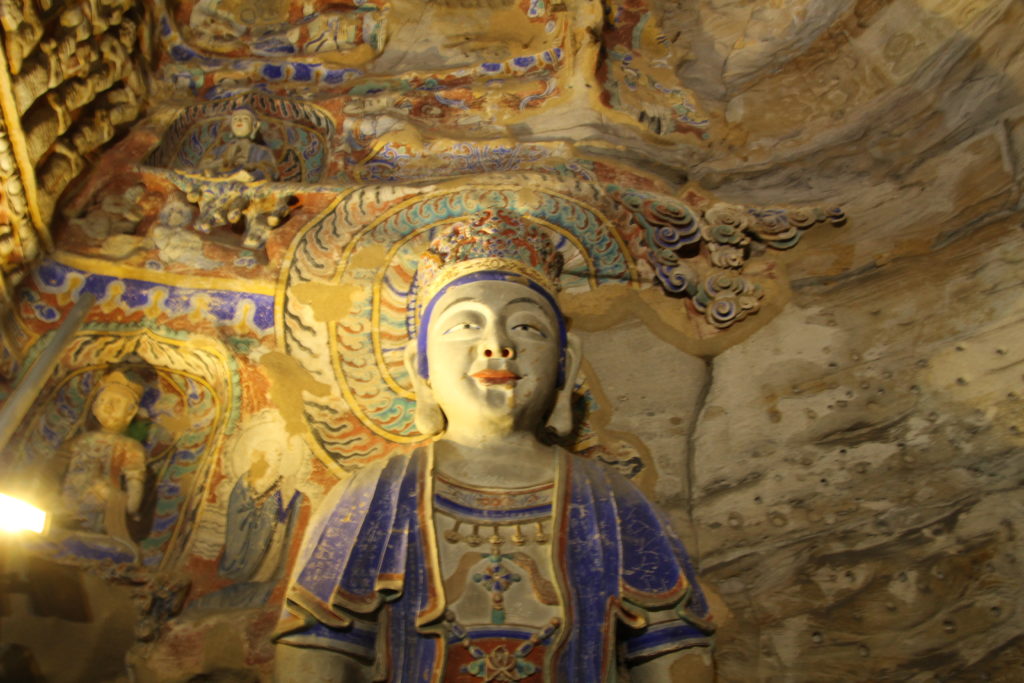
Incredibly vibrant colors considering the age of all the carvings
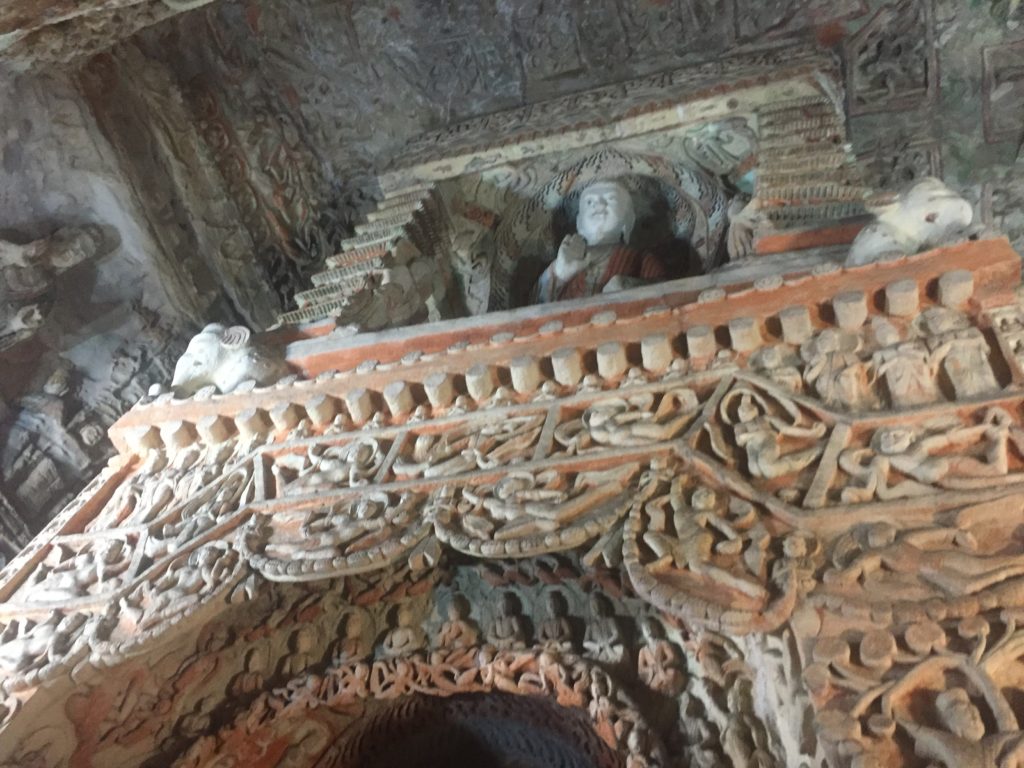
The carvings go all the way to the ceiling
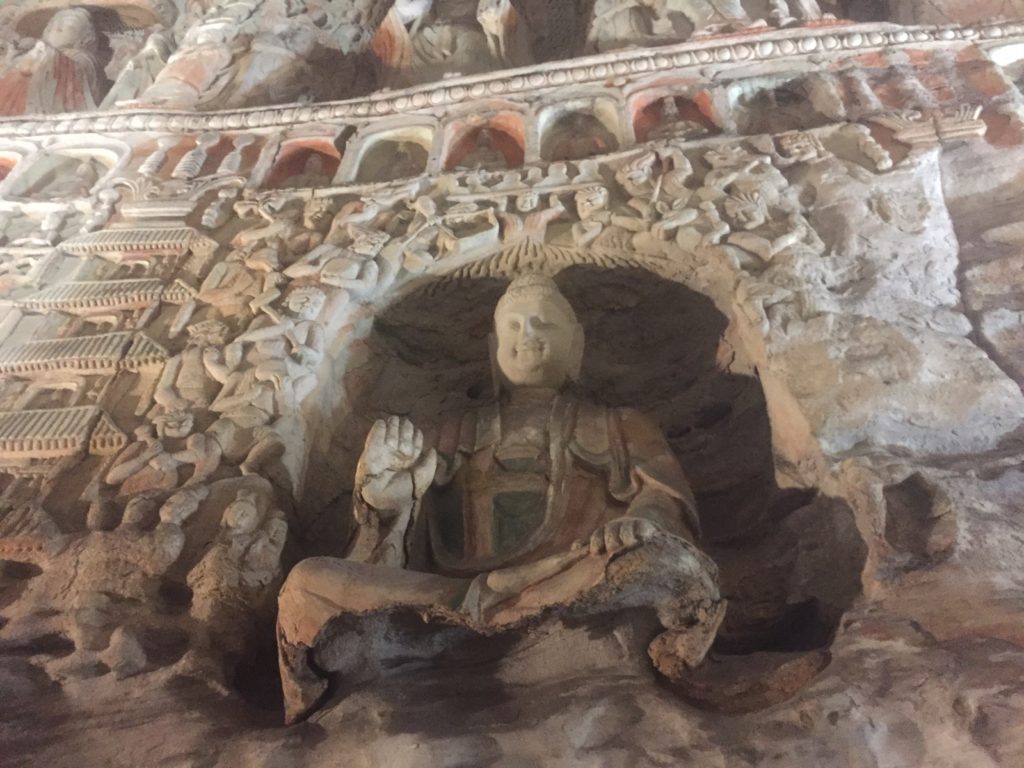
Insane details everywhere
The next few caves thereafter were similarly exceptional to the first two, making it all somehow seem normal. China would be the one place in the world that would cause visitors to take for granted hand carved 50 feet tall stone Buddhas and other scenery. Ridiculous. One of my favorite caves had the standard gigantic Buddha inside, but also a crap ton of tiny Buddhas meticulously carved along the face and the inside of the cave. The description outside the cave explained that it has once been known as the “Cave of a Thousand Buddhas,” but eventually so many were carved into it that they had to rename it the “Cave of Ten Thousand Buddhas”. Are you beginning to comprehend the scale of absurdity we were confronted with here? Am I getting my point across?!

Part of a wall in the Cave of Ten Thousand Buddhas
After we wandered through a number of these caves and thought we had fully exhausted the splendor of this location, we turned a final corner thinking that we’d begin making our way towards the exit. What we were confronted with, however, were several gigantic and vibrant Buddha statues carved into the face of the cliff, rather than being tucked away into caves. These were a cherry on the top of the proverbial sundae, as they truly cemented the impression we had in our minds that this was one of the most spectacular destinations either of us have ever visited.

Panorama of several open-air giant Buddhas at the end of the grottoes
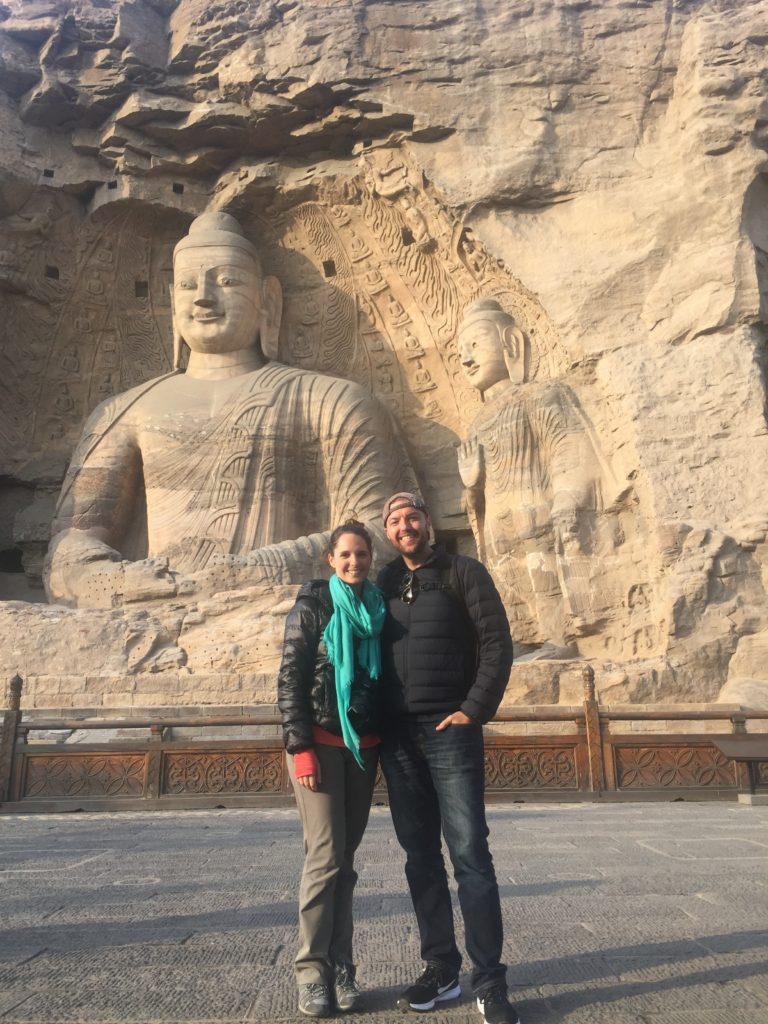
Making some Chinese tourists very happy by asking them to take our picture
[Editor’s note: Rorie covered the two main sites above, but I thought it was worth spending just a minute on the city of Datong itself. The below paragraphs about the city are mine.]
Datong is, as mentioned, a huge city of several million people. However, we were staying in the Ancient Quarter, a section literally walled off by a huge, turret-filled wall with ornate pagodas and archways at every large, multi-lane roundabout. Several areas were also pedestrian-only, including where our hostel was located, and the streets were wide, clean, and empty. We saw almost no people at all walking around, while still seeing the potential for huge crowds given the scale and number of businesses. It had the slightly eerie feeling of being the off-season at a summer getaway, where you can tell that at some point there are hordes of people, just not now. Yet, I don’t think Datong *is* a summer getaway, at least not that we could tell, so this remains something of a mystery. If anyone out there has any insight, please comment and let us know!
After some wandering, we found multiple really cute coffee shops that would have been the new neighborhood hotspot if plopped down in Brooklyn tomorrow. By the end of our few days there, we had pretty much mastered the few blocks around our hostel – which felt like more than enough of an accomplishment in and of itself. I really enjoyed Datong, and despite the strange desertedness felt somehow more comfortable than I had in Beijing. It’s funny how certain places will do that.
[Ok, back to Rorie.]
Conclusion
By the time we finished traipsing around Datong that day, we were rather fatigued but also riding a high after some of the most amazing sights either of us had ever seen. What makes it all the more remarkable is that these destinations are totally off the normal tourist radar – we saw almost zero Western tourists in Datong, since most travelers to China choose to hole themselves up in large, safe, mainstream cities (e.g., Hong Kong, Shanghai, Beijing). In light of this, it was hard not to feel extremely fortunate that our style and duration of travel is affording us the opportunity to explore some more obscure, but supremely rewarding, destinations in the world, with Datong being the first of (hopefully!) many to meet that standard.
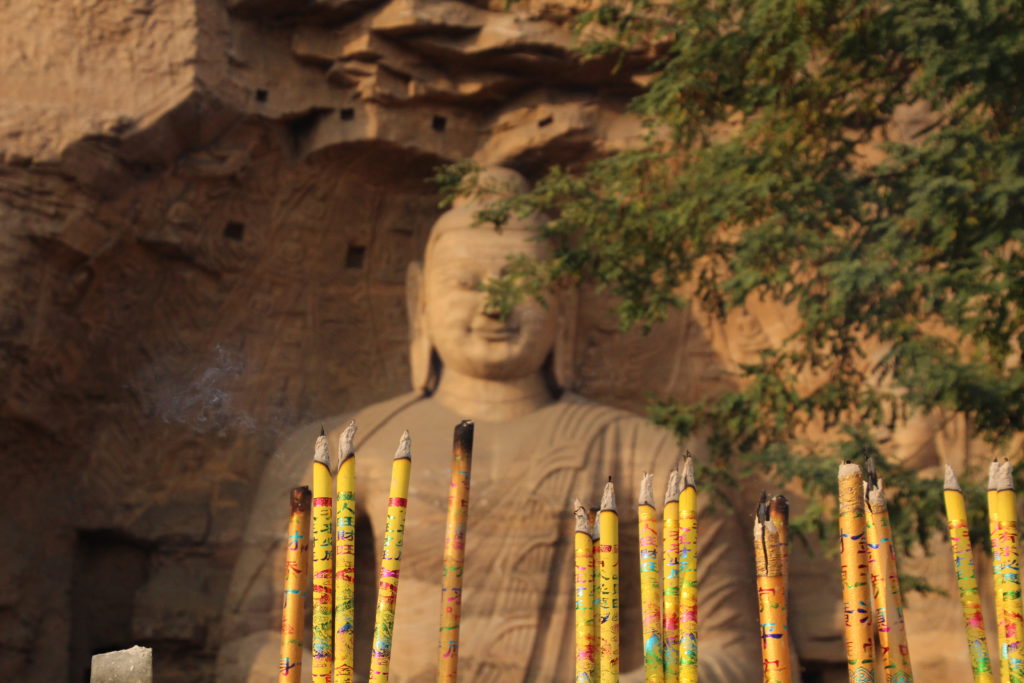
Giant Buddha behind burning incense at Yungang Grottoes
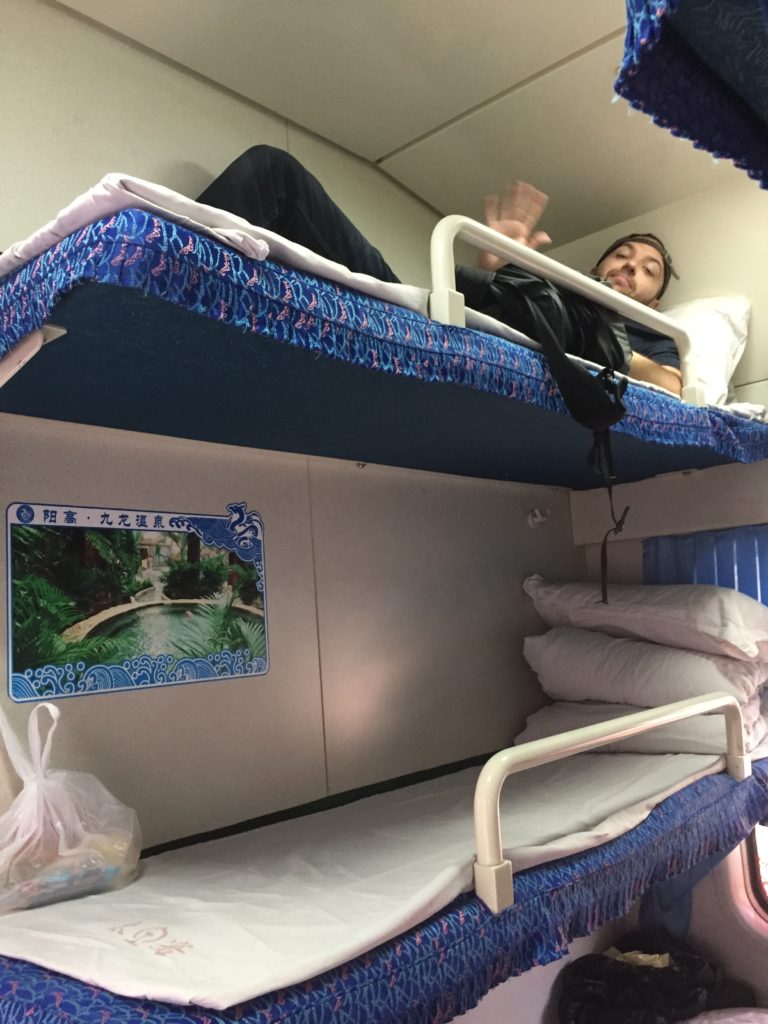
Rorie in the top bunk of a “hard sleeper” type train: three levels of beds in a compartment open to the rest of the train. Rorie was extremely graceful climbing up there, trust me.


